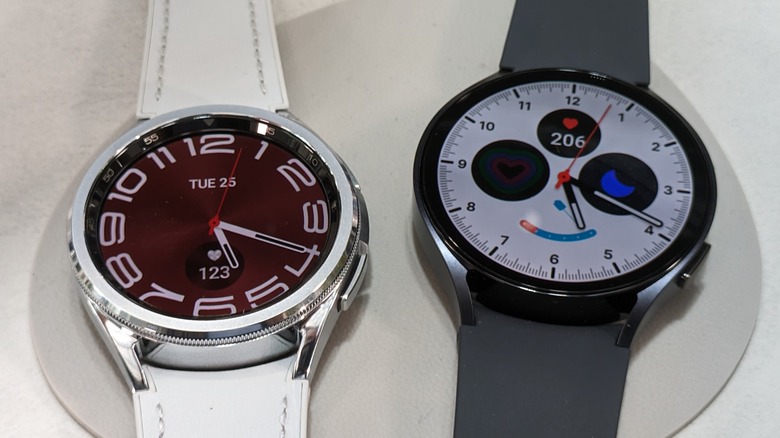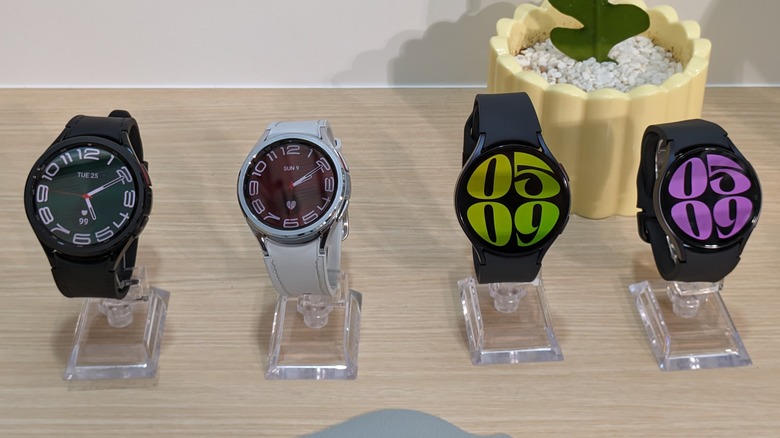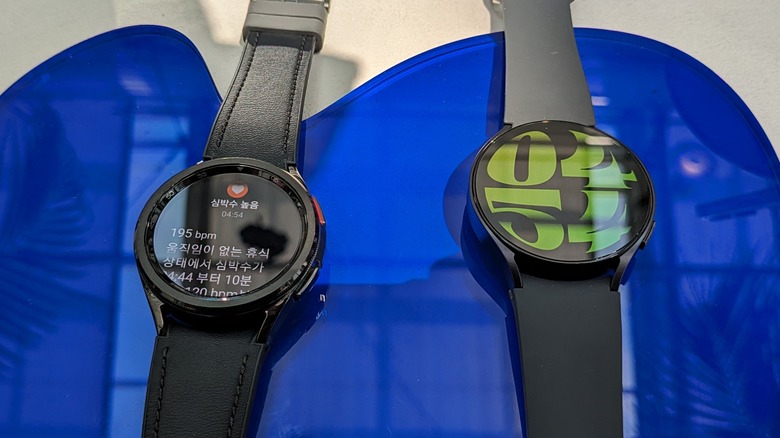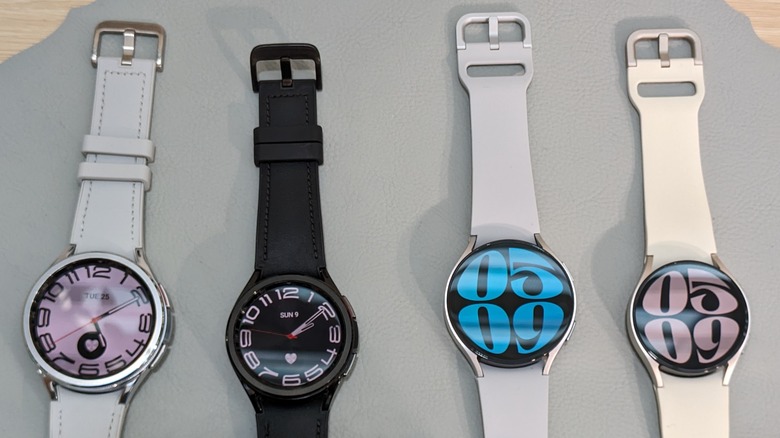Galaxy Watch 6 Vs. Galaxy Watch 6 Classic: What's The Difference?
Samsung has pulled the wraps off its newest flagship foldable smartphones, tablets, and smartwatches at its second Unpacked event of 2023. With these announcements, the Galaxy Watch 6 and the Galaxy Watch 6 Classic now sit on top of Samsung's lineup of smartwatches. The Classic, in particular, marks the revival of the beloved rotating bezel dial, which was previously ditched from the lineup when Samsung launched the Galaxy Watch 5 Pro.
The duo brings improved metrics for fitness and health data, more comprehensive sleep tracking, and better insights related to menstrual cycles. They are also the first set of smartwatches to run on Google's latest WearOS 4, with Samsung's most up-to-date One UI 5 Watch interface on top.
Besides new software features, the Galaxy Watch 6 series gets noted hardware improvements, including a new processor and more RAM for better management of active apps. The displays are now much brighter and offer distinct controls for the Always-On mode.
The new infrared sensor measures any changes in skin temperature, while a new locking mechanism for the band allows instant latching. And, there are hundreds of official band options to choose from.
While both smartwatches have countless new features and plenty of similarities, certain differences set the Galaxy Watch 6 and Watch 6 Classic apart.
Design differences
The most evident difference between the Galaxy Watch 6 and the Galaxy Watch 6 Classic is the rotating bezel, which is a much-loved feature that returns only on the Classic model. Like previous generations, the rotating bezel can be used to scroll through the interface or change values in fields with numeric inputs.
The next distinction comes from the different sizes in which these smartwatches are available. The Galaxy Watch 6 comes in two sizes — a 40 mm (in diameter) dial available in graphite and gold colors, and a 44 mm dial available in graphite and silver.
Despite the different finishes, the casing on both sizes is made with aluminum and features silicone-based bands. The difference in sizes also impacts the weights of the Galaxy Watch 6; with the 40 mm variant weighing 28.7 grams, while the bigger 44 mm variant weighs 33.3 grams.
Likewise, the Galaxy Watch 6 Classic also comes with dials in two sizes, both slightly bigger than the non-Classic variant watch. First, the smaller variant has a 43 mm dial, while the bigger version features a 47 mm dial.
Unlike the vanilla Galaxy Watch 6, the Watch 6 Classic has a stainless steel housing with silver and black color options. Stainless steel also results in a heftier build, with the 47 mm variant weighing 59 grams, and the 43 mm variant weighing 52 grams. The strap is also distinct and made of eco-leather instead of silicone.
Which display is better?
Despite variations in the dial size, the Galaxy Watch 6 and the Galaxy Watch 6 Classic have identical displays for the smaller and larger variants. The 44 mm Watch 6 and 47 mm Watch 6 Classic have the same circular 1.5-inch Super AMOLED display.
This is bigger than the 1.36-inch AMOLED seen on the larger variants in the previous generations, i.e., Watch 5 and Watch 4. With the larger display, Samsung also bumps up the display's resolution to 480x480 pixels on the 44 mm Galaxy Watch 6 and the 47 mm Galaxy Watch 6 Classic.
Similarly, the smaller variants — the 40 mm Galaxy Watch 6 and the 43 mm Galaxy Watch 6 Classic — share the same 1.3-inch circular display. This also marks an upgrade over the 1.2-inch display seen previously on the 40 mm Galaxy Watch 5 (the Watch 5 Pro came in a single variant). The resolution on both smartwatches is also identical at 432x432 pixels.
The marginally bigger displays allow for more text to be visible and increase the area available to use the coin-sized QWERTY swipe keyboard. At the same time, the bezels feel less of an eyesore, being roughly 30% smaller than previous generations.
To add to this, Samsung claims the displays can now reach a peak brightness of up to 2,000 nits, allowing easy visibility under even the brightest sunlight. This especially benefits the Always-On Display, where the brightness can be adjusted separately from the main display.
Which has the longest-lasting battery?
Besides variations in design and display, the Galaxy Watch 6 and the Galaxy Watch 6 Classic also differ in terms of battery power. The 44 mm Galaxy Watch 6 packs a 425 mAh battery, which is a marginal improvement over the 410 mAh battery available on the 44 mm Galaxy Watch 5. The smaller 40 mm Watch 6 gets a bigger battery rated at 300 mAh, compared to the 275 mAh power pack on the 40 mm Galaxy Watch 5.
Once again, we see the same pattern of sharing specifications across the non-Classic and Classic variants based on size. Therefore, the 47 mm and the 43 mm Galaxy Watch 6 Classic also get batteries specified at 425 mAh and 300 mAh, respectively. This is a notable downgrade from the chunky 510 mAh battery we saw last year on the Galaxy Watch 5 Pro.
Despite the dissimilar battery capacities, Samsung makes a universal claim about battery life: All these Galaxy Watch 6 and Watch 6 Classic models are expected to last up to 30 hours with Always-On Display, and 40 hours without it.
When it comes to charging, Samsung is sticking to the same proprietary puck-shaped magnetic charger from 2022. The charger included in the packaging is rated at 10W, which was bumped up from 5W last year.
The biggest question for many: Price
The final deciding factor will be the price, which varies per model. The 40 mm Galaxy Watch 6 is $299.99, while the bigger 44 mm variant is priced at $329.99. The two Galaxy Watch 6 models will offer LTE support at an extra cost of $50, which increases the prices to $349.99 and $379.99, respectively.
Similarly, the 43 mm variant of Galaxy Watch 6 Classic is priced at $399.99, whereas the 47 mm variant comes in at $429.99. Additional LTE connectivity will similarly increase the Classic model's prices, raising them to $449.99 and $479.99 for the 43 mm and 47 mm, respectively.
If you're not obsessed with the rotating dial, common features on the Galaxy Watch 6 and Watch 6 Classic help you save some money. These include the improved personalized heart rate zones that define goals for time spent in different heart rate zones for optimal workout intensity, reduce chances of burnout, and improve recovery prospects.
Besides the pre-existing ECG feature, Samsung is adding an Irregular Heart Rhythm Notification to identify chances of Atrial fibrillation (AFib) based on continuous background scanning.
Lastly, the new One UI 5 Watch update brings additional apps, including Audible and Gmail. A new API will allow data from the temperature sensor to be indexed by other apps as well — such as Peloton and MyFitnessPal — for better contextual information about nutrition and the calories burnt during the workout. Samsung gives plenty of options here for prospective Galaxy watch buyers.




